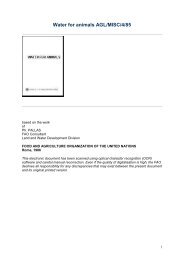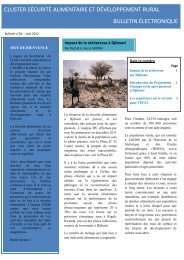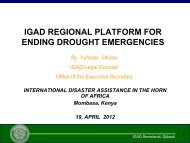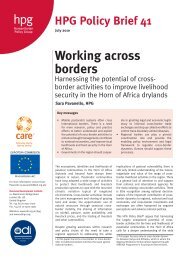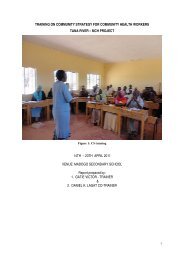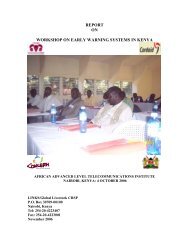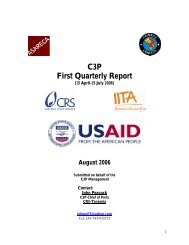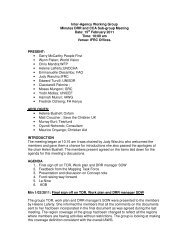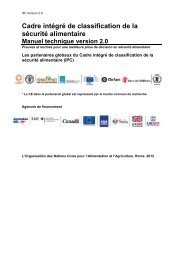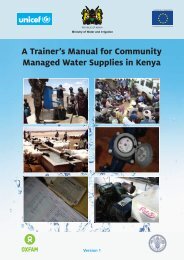Synthesis of Existing Knowledge and Experience on the Provision of ...
Synthesis of Existing Knowledge and Experience on the Provision of ...
Synthesis of Existing Knowledge and Experience on the Provision of ...
You also want an ePaper? Increase the reach of your titles
YUMPU automatically turns print PDFs into web optimized ePapers that Google loves.
EXECUTIVE SUMMARYWater development has <strong>the</strong> potential to bring lasting change in <strong>the</strong> l<strong>on</strong>g term – both positive <str<strong>on</strong>g>and</str<strong>on</strong>g>negative. In Ethiopia’s arid areas, where pastoralism is <strong>the</strong> dominant livelihood, practical fieldexperience over <strong>the</strong> last forty years indicates that water point development divorced from an indepthunderst<str<strong>on</strong>g>and</str<strong>on</strong>g>ing <str<strong>on</strong>g>of</str<strong>on</strong>g> pastoral livelihoods can compromise sustainable development in <strong>the</strong> l<strong>on</strong>gterm despite stemming water shortages in <strong>the</strong> short term.To date, no broad overview exists <str<strong>on</strong>g>of</str<strong>on</strong>g> water development in Ethiopia’s pastoral regi<strong>on</strong>s. This reportaims to fill this gap <str<strong>on</strong>g>and</str<strong>on</strong>g> presents a syn<strong>the</strong>sis <str<strong>on</strong>g>of</str<strong>on</strong>g> experience over <strong>the</strong> last forty years in <strong>the</strong> waterdevelopment sector in <strong>the</strong> country’s pastoral regi<strong>on</strong>s. The purpose <str<strong>on</strong>g>of</str<strong>on</strong>g> this report is to first <str<strong>on</strong>g>and</str<strong>on</strong>g>foremost inform <str<strong>on</strong>g>and</str<strong>on</strong>g> improve <strong>the</strong> quality <str<strong>on</strong>g>of</str<strong>on</strong>g> project partners’ 1 work. It is also hoped that thissyn<strong>the</strong>sis usefully informs <strong>the</strong> water development sector more broadly.The report presents an overview <str<strong>on</strong>g>of</str<strong>on</strong>g> past <str<strong>on</strong>g>and</str<strong>on</strong>g> current approaches to water development, who isinvolved, where, how, <str<strong>on</strong>g>and</str<strong>on</strong>g> whe<strong>the</strong>r less<strong>on</strong>s have been learned <str<strong>on</strong>g>and</str<strong>on</strong>g> approaches changed over time –all within <strong>the</strong> framework <str<strong>on</strong>g>of</str<strong>on</strong>g> nati<strong>on</strong>al <str<strong>on</strong>g>and</str<strong>on</strong>g> regi<strong>on</strong>al policies, plans, <str<strong>on</strong>g>and</str<strong>on</strong>g> strategies. It essentiallyexamines <strong>the</strong> work d<strong>on</strong>e by <strong>the</strong> partners <str<strong>on</strong>g>and</str<strong>on</strong>g> o<strong>the</strong>r actors, as well as takes a close look at policiesrelevant to water development in pastoral areas. The report also aims to identify opportunities <strong>on</strong>which to build which can enhance <strong>the</strong> positive effects <str<strong>on</strong>g>of</str<strong>on</strong>g> water development for lives <str<strong>on</strong>g>and</str<strong>on</strong>g> livelihoods.It is recognized that pastoralists are not simply recipients <str<strong>on</strong>g>of</str<strong>on</strong>g> development, but are drivers <str<strong>on</strong>g>of</str<strong>on</strong>g> change<strong>the</strong>mselves, as attested to by <strong>the</strong> complex Borana well systems in sou<strong>the</strong>rn Ethiopia <str<strong>on</strong>g>and</str<strong>on</strong>g> <strong>the</strong>pastoralist-led introducti<strong>on</strong> <str<strong>on</strong>g>of</str<strong>on</strong>g> birkado 2 to <strong>the</strong> Somali regi<strong>on</strong> in <strong>the</strong> 1960s. Pastoral water pointc<strong>on</strong>structi<strong>on</strong> significantly predates <strong>the</strong> involvement <str<strong>on</strong>g>of</str<strong>on</strong>g> <strong>the</strong> state <str<strong>on</strong>g>and</str<strong>on</strong>g> o<strong>the</strong>r actors. Customary watermanagement practices were (<str<strong>on</strong>g>and</str<strong>on</strong>g> still are) tailored to a mobile livelihood system, which itself is aresp<strong>on</strong>se to <strong>the</strong> requirements <str<strong>on</strong>g>of</str<strong>on</strong>g> dryl<str<strong>on</strong>g>and</str<strong>on</strong>g> envir<strong>on</strong>ments where climate is highly variable in time <str<strong>on</strong>g>and</str<strong>on</strong>g>space. Pastoralists use water management as a means to manage <strong>the</strong> wider rangel<str<strong>on</strong>g>and</str<strong>on</strong>g>s, aware thataccess to <str<strong>on</strong>g>and</str<strong>on</strong>g> availability <str<strong>on</strong>g>of</str<strong>on</strong>g> water affects who <str<strong>on</strong>g>and</str<strong>on</strong>g> how many have access to surrounding pasture <str<strong>on</strong>g>and</str<strong>on</strong>g>grazing areas. At <strong>the</strong> same time, some pastoralist-led water developments have been shown tohinder pastoral livelihoods. The negative c<strong>on</strong>sequences <str<strong>on</strong>g>of</str<strong>on</strong>g> birkado for rangel<str<strong>on</strong>g>and</str<strong>on</strong>g> health <str<strong>on</strong>g>and</str<strong>on</strong>g> pastoralmobility were observed when people began to permanently settle in wet seas<strong>on</strong> grazing areas, using<strong>the</strong> rangel<str<strong>on</strong>g>and</str<strong>on</strong>g>s year-round in areas formerly allowed to rest <str<strong>on</strong>g>and</str<strong>on</strong>g> regenerate for parts <str<strong>on</strong>g>of</str<strong>on</strong>g> <strong>the</strong> year.The c<strong>on</strong>centrati<strong>on</strong> <str<strong>on</strong>g>of</str<strong>on</strong>g> livestock in limited areas also made herds more vulnerable to disease. Theseimpacts have today been recognized in some areas by pastoralists <str<strong>on</strong>g>and</str<strong>on</strong>g> o<strong>the</strong>rs (notably somedevelopment organizati<strong>on</strong>s), <str<strong>on</strong>g>and</str<strong>on</strong>g> pastoral communities have begun to take active first steps toaddress <strong>the</strong> problems by putting in place binding customary agreements. In o<strong>the</strong>r parts, birkadoc<strong>on</strong>tinue to be a popular feature <strong>on</strong> <strong>the</strong> water development opti<strong>on</strong>s list.From <strong>the</strong> 1970s, especially after severe drought in 1973, pastoral regi<strong>on</strong>s became a focus <str<strong>on</strong>g>of</str<strong>on</strong>g>attenti<strong>on</strong> for government as well as nati<strong>on</strong>al <str<strong>on</strong>g>and</str<strong>on</strong>g> internati<strong>on</strong>al development <str<strong>on</strong>g>and</str<strong>on</strong>g> humanitarianagencies. Soluti<strong>on</strong>s to water shortages at <strong>the</strong> time were technocratically driven <str<strong>on</strong>g>and</str<strong>on</strong>g> top down, withlittle participati<strong>on</strong> from <strong>the</strong> grassroots. Interventi<strong>on</strong>s aimed to settle pastoralists – to ‘bring order’ to<strong>the</strong>ir way <str<strong>on</strong>g>of</str<strong>on</strong>g> life which was seen as backward <str<strong>on</strong>g>and</str<strong>on</strong>g> outmoded. There was little underst<str<strong>on</strong>g>and</str<strong>on</strong>g>ing thatmobility is a sophisticated resp<strong>on</strong>se to <strong>the</strong> unique characteristics <str<strong>on</strong>g>of</str<strong>on</strong>g> dryl<str<strong>on</strong>g>and</str<strong>on</strong>g> envir<strong>on</strong>ments, <str<strong>on</strong>g>and</str<strong>on</strong>g> is1 The partners are <strong>the</strong> RiPPLE Programme, funded by UKaid from <strong>the</strong> Department for Internati<strong>on</strong>alDevelopment through ODI, SC-US working through <strong>the</strong> USAID funded Enhanced Livelihoods in Sou<strong>the</strong>rnEthiopia/Enhanced Livelihoods in <strong>the</strong> M<str<strong>on</strong>g>and</str<strong>on</strong>g>era Triangle (ELSE/ELMT) programme, <str<strong>on</strong>g>and</str<strong>on</strong>g> CARE Ethiopia, working through <strong>the</strong>Howard G. Buffet Foundati<strong>on</strong> funded Global Water Initiative.2 Cement lined underground cisterns.10



